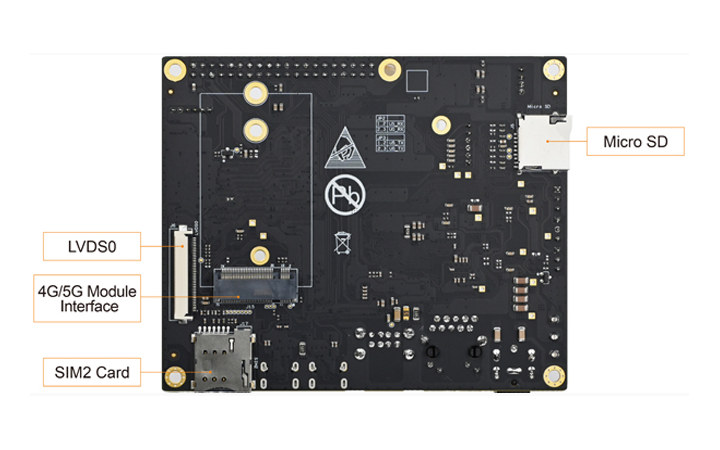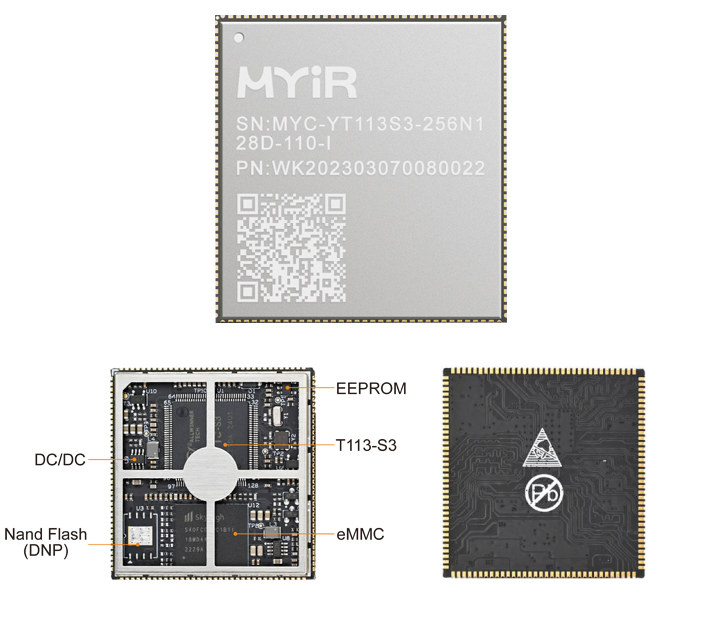MYiR MYC-YT113X is a low-cost solderable CPU module powered by an Allwinner T113-S3 dual-core Cortex-A7 processor with 128MB on-chip DDR3 RAM, and fitted with either a 256MB NAND flash or a 4GB eMMC flash for storage.
The industrial temperature grade module provides a lower-end alternative to the company’s earlier MYC-YT507H Allwinner T507-H Cortex-A53 CPU module, and offers various display, camera, audio, Ethernet, USB, and low-speed I/Os through a 140-pin stamp hole design. It is designed for HMI, industrial automation, as well as display and control terminals.
MYiR MYC-YT113X specifications:
- SoC – Allwinner T113-S3
- CPU – Dual-core Arm Cortex-A7 @ 1.2 GHz with 32 KB L1 I-cache + 32 KB L1 D-cache per core, and 256 KB L2 cache
- DSP – Single-core HiFi4
- VPU – H.265/H.264 video decoding up to 1080p60 and JPEG/MJPEG video encoding up to 1080p60
- Memory – 128 MB DDR3
- Storage – 4GB eMMC or 256MB NAND flash, 32KB EEPROM
- 1.0mm pitch 140-pin stamp hole expansion interface
- Display I/F
- 1x MIPI DSI
- 1x RGB
- 1x single-channel LVDS and 1x dual-channel LVDS or 24-bit RGB (supports up to 1080p60)
- Camera I/F – 1x Parallel CSI
- Audio – 2x I2S
- Ethernet – 1x RGMII/RMII
- USB – 2x USB2.0
- Analog – 1x GPADC and 4x TRADC
- Low-speed I/Os – 6x UART, 2x CAN, 4x TWI/I2C, 2x SPI, up to 59 GPIOs
- Display I/F
- Power supply – 5V/1A
- Dimensions – 39 x 37mm (6-layer PCB design)
- Temperature Range – -40 to 85 Celsius (industrial grade)
MYiR also designed the MYD-YT113X development board to evaluate the MYC-YT113X Allwinner T113-S3 CPU module with the following specifications:
- System-on-module – MYC-YT113X CPU module described above
- Storage – MicroSD card slot
- Video Output
- Single-channel LVDS display interface (LVDS0, 40-pin 0.5mm pitch FPC connector) for MYIR’s MY-LVDS070C LCD module with a capacitive touchscreen
- Dual-channel LVDS display interface (LVDS, 30-pin 2.0mm pitch header connector)
- Audio – 4-pin audio output connector
- Networking
- Gigabit Ethernet RJ45 port
- USB-based WiFi module
- Optional 4G LTE/5G module via M.2 socket (USB) and two SIM card slots.
- USB
- 2x USB 2.0 host ports
- 1x USB 2.0 OTG Type-C port
- Serial ports – 1x Debug UART (TTL), 4x TTL serial ports
- Expansion – 40-pin Raspberry Pi-compatible GPIO header with TWI, UART, etc.. and supporting MYIR’s MY-WIREDCOM RPI module to add CAN and RS232 interfaces
- Misc – Power Switch, Reset button, user-programmable button
- Power Supply – 12V/2A via DC jack
- Dimensions – 110 x 90mm (4-layer PCB)
- Temperature Range – -40 to 85 Celsius, but note the WiFi module is limited to -20 to 70 Celsius

MYiR provides a Linux BSP with kernel version 5.4.61, U-boot 2018.05, and the drivers for all peripherals, along with source code, and two root file systems, one minimal, one with a GUI. None of those is released publicly, so only customers would have access to it. There’s however some public code for other Allwinner T113-S3 hardware platforms, as we previously covered MangoPi MQ-Dual board and the 100ASK-T113-Pro development board, and its associated T113-S3 Core Lite CPU module.
The MYC-YT113S3-256N128D-110-I CPU module (256 NAND flash) is sold for $14, while the MYC-YT113S3-4E128D-110-I system-on-module with 4GB eMMC flash is offered for $17, while the respective development kits with all accessories (power supply, cables …) for $55 and $59. The optional MY-WIREDCOM for CAN Bus and RS485 adds $25, and the 7-inch touchscreen display is sold for $99. You’ll find the full details and purchase links on the product page.

Jean-Luc started CNX Software in 2010 as a part-time endeavor, before quitting his job as a software engineering manager, and starting to write daily news, and reviews full time later in 2011.
Support CNX Software! Donate via cryptocurrencies, become a Patron on Patreon, or purchase goods on Amazon or Aliexpress






